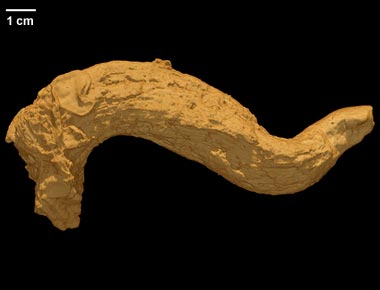The imagery on this page was the basis for a paper entitled Rudist Taxonomy using X-ray Computed Tomography, by A. Molineux, R.W. Scott, R.A. Ketcham and J.A. Maisano (Palaeontologia Electronica 10.3.13A, 2007).
Rudists were aberrant sessile suspension-feeding marine bivalves. They existed from the late Jurassic through the Cretaceous, becoming major constituents of the carbonate platform biota, where they formed extensive 'meadows' and low mounds. Some scientists suggest that they replaced corals as important reefal organisms in the later Cretaceous. Their shell structure and form evolved from a pair of coiled valves with a thin aragonitic shell, to heavily calcified, thick-walled de-contorted forms in which the unattached valve became opercular. Uncoiling enabled shell accretion along the mantle margin and the growth of conical forms. Rudists have been classified into three major morphotypes, each adapted to their particular environment. Elevators are supported by sediment, clingers attach to another hard surface, and recumbents largely rested upon the sediment surface. Cladistic analysis of the rudist bivalves suggests that several of the families are paraphyletic (Diceratidae, Monopleuridae) or polyphyletic (Caprotinidae, Caprinidae) (Skelton, 1978; Skelton and Smith, 2000)
The caprinid, Caprinuloidea perfecta, has been recovered from Lower to basal Upper Albian-aged rocks in the southwestern United States (Scott, 2002). Major characteristics of this genus include two valves, two teeth in the left valve (free valve) and one tooth in the right (fixed), body cavity, accessory cavity, pallial canals, external ligament groove, and ligament ridge and muscle attachment sites (myophores).
Caprinuloidea perfecta is highly inequivalved. The right or attached valve is long and curved with a slight rotational twist. The cross-section is close to quadrilateral. The free, or left valve, is much smaller and coiled and is crushed in this specimen. The shell structure includes ventrally trifurcating marginal plates cut by radial plates to form two rows of polygonal canals (coronal slice127). The body cavity is slightly off center, with anterior and posterior tooth sockets separated by the ligament ridge on the dorsal side. The ventral side is thus the thinner side of the skeleton and perhaps the recumbent side or attached side. (coronal slice1205) The ligament groove is external (surface roll movie) and attaches on the ligament ridge.
Taxonomy:
Phylum: Mollusca
Class: Bivalvia (Bonnani, 1681) Linné, 1758
Subclass: Heterodonta Neumayer, 1884
Order: Hippuritoida Newell, 1965
Superfamily: Hippuritoidea Gray, 1848
Familiy: Caprinidae d’Orbigny, 1850
Subfamily: Caprinuloidinae Mac Gillavry, 1970
Genus: Caprinuloidea
Type species: Caprinuloidea perfecta Palmer, 1928 (One of nine species currently assigned to this genus)
Additional Information
Click on the thumbnail below for labeled imagery of the specimen.

Literature
Chubb, L.J. 1967. New rudist species from the Cretaceous rocks of Jamaica. Journal of the Geological Society of Jamaica 9:24-31.
Chubb, L.J. 1971. Rudists of Jamaica. Palaeontographica Americana 7:157-257.
Coogan, A.H. 1973. New rudists from the Albian and Cenomanian of Mexico and south Texas. Revista del Instituto Mexicano del Petróleo 5:51-83.
Coogan, A.H. 1977. Early and middle Cretaceous Hippuritacea (rudists) of the Gulf Coast. University of Texas at Austin, Bureau of Economic Geology, Report of Investigation. Bebout, D.G., Loucks, R.G. (eds.), Cretaceous carbonates of Texas and Mexico 89:32-70.
Davis-Strickland, E.R. and Donovan, S.K. 1993. Key for field identification of rudist bivalves from the Cretaceous of Jamaica. Caribbean Journal of Science 29:267-271.
Mac Gillavry, H.J. 1937. Geology of the province of Camaguey, Cuba, with revisional studies in rudist paleontology. Geographische en geologische Mededeelingen 14:1-168.
Palmer, R.H. 1928. The rudistids of southern Mexico. Occasional Papers of the California Academy of Sciences 14:1-137.
Payne, J.L, Johnson, M.E., Ledesma-Vazquez, J. 2004. Lower Cretaceous Alisitos Formation at Punta San Isidro: coastal sedimentation and volcanism. Ciencias Marinas 30:365-380.
Scott, R.W. 1981. Biotic relations in early Cretaceous coral-algal-rudist reefs, Arizona. Journal of Paleontology 55:463-478.
Scott, R.W. 1990. Models and stratigraphy of mid-Cretaceous reef communities, Gulf of Mexico. Society for Sedimentary Geology, Concepts in Sedimentology and Paleontology 2:1-102.
Scott, R.W. 2002. Albian caprinid rudists from Texas re-evaluated. Journal of Paleontology 76:408-423.
Skelton, P.W. 1978. The evolution of functional design in rudists (Hippuritacea) and its taxonomic implications. Philosophical Transactions of the Royal Society of London, Series B 284:305–318.
Skelton, P.W. 1996. IGCP Project 364: Correlation of Caribbean ophiolites and volcanic arcs - field meeting. Episodes 19:27-28.
Skelton, P.W. and Smith, A.B. 2000. A preliminary phylogeny for rudist bivalves: sifting clades from grades. In: Harper, E.M., Taylor, J.D. & Crame, J.A. (eds.): The Evolutionary Biology of the Bivalvia. Geological Society Special Publication, p. 97–127.
Sohl, N.F. 1976. Note on middle Cretaceous macrofossils from the Greater Antilles. Annales du Muséum d'Histoire naturelle de Nice 4:XXXI.1-XXXI.6.
Thiadens, A.A. 1936. On some caprinids and a monopleurid from southern Santa Clara. Koninklijke Akademie van Wetenschappen te Amsterdam, Proceedings of the Section of Sciences 39:1132-1141.




 ,
, 






